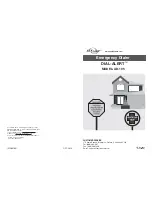
88
Operating the base's answering machine
Gigaset DX800A all in one / USA EN / A31008-xxxxx-xxxx-x-xxxx / answering_m.fm / 06.09.11
V
e
rsion 4, 16.0
9
.2005
Setting the recording
parameters
The answering machine has already been
preset at the factory. You can adjust individ-
ual settings via the base or a registered
handset.
v
¢
Ì
¢
Recordings
¤
You can enter data in the following fields:
Length:
Select maximum recording length
1 min.
,
2 min.
,
3 min.
or
Maximum
..
Quality:
Select
Excellent
or
Long Play
recording
quality. If the quality is higher, the maxi-
mum recording time is reduced.
Ring Delay:
Select when the answering machine
should accept a call:
Immediately
, after
10 sec.
,
18 sec.
,
30 sec.
or
Automatic
.
§Save§
Press the display key.
Information about ring delay
In
Automatic
mode, the following applies
for ring delay:
u
If there are no new messages, the answer-
ing machine answers a call after
18 seconds.
u
If new messages are present, the answer-
ing machine answers a call after 10 sec-
onds.
When operating remotely
(
¢
page 88)
,
you can tell after approx. 15 seconds that
there are no new messages (otherwise the
answering machine would have already
accepted your call). There are no call charges
if you hang up now.
Changing the language for the
voice prompt and default
announcement
v
Open the main menu.
*#Q5#2
Enter digits
and
press
Q
§OK§
To set English.
§OK§
To set French.
2
§OK§
To set Spanish.
Operating when on the move
(remote operation)
You can check and activate your answering
machine from any other telephone (hotel,
pay phone etc.).
Prerequisites:
u
You have set a system PIN other than
0000
(page 117)
.
u
The phone you are using for remote oper-
ation has tone dialling (DTMF) i.e., you
hear different tones when you press the
keys. Alternatively, you can use a code
transmitter (available from retailers).
u
The connection via which you call is
assigned to the answering machine as a
receive connection.
Please note
Remote operation via VoIP connections
is possible as long as DTMF signals are
transmitted (depending on the provider)
as SIP info messages, audible signals in
the voice channel (inband or audio) or as
special RTP data packets (pursuant to
RFC2833).
















































